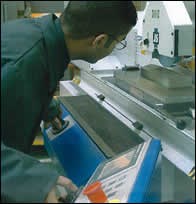Taking The "Magic" Out Of Grinding
This grinding machine builder has introduced a new CNC surface and profile grinder to help shops bridge the machinists' skills gap.
Share




Increasingly, many of the metalworking skill sets that once resided with machinists are being relocated within the computer numerical control. Shops that have seen the attrition of the skilled workforce and endured the difficulty in finding equivalent replacements are looking to automation to keep the work flowing through the shop.
To that end, grinding machine builder Jones & Shipman (Farmington, Connecticut) has introduced a new CNC surface and profile grinder to help shops bridge the machinists’ skills gap. The series is called 524 Easy, and it’s designed with a proprietary, CNC-embedded, programming system that enables an operator with little or no CNC knowledge to create precise, complex grinding programs.
The goal behind development of the 524 Easy is to help improve the productivity of shops that use surface and profile grinders for tool room and production applications. For surface and profile grinding, reduction of setup, wheel preparation, try-out and operation are all areas ripe for improvement. Using a Fanuc touchscreen control, loaded with Jones & Shipman’s own icon driven software, the difficulty of programming simple or complex parts is made significantly easier for operators of virtually any experience level.
At start-up, the operator is offered three basic options from which to choose. The operator selects from manual, dress or grind cycle modes, which are accessed by hitting the control’s touchscreen membrane panel.
In the manual mode, the machine is operated as a simple manual machine. Electronic handwheels are used to operate the machines axes. For manual operation, dressing increments, grinding speeds and feeds are adjustable using the touchscreen on the CNC. The rest of the machine’s operation is manual.
Choosing the dress mode on the CNC brings up five standard wheel options from which to automatically create the desired wheel profile. These profiles are straight, facing, slotting, vee-form, and full ISO. After selecting one of these forms, specific dimensions, radii and other profile data are entered using an icon driven menu on the CNC touchscreen. Dress increments, speeds and feeds are selectable using graphic menus.
In the third mode, grind, the complexity of the workpiece is the deciding factor for the number of grind cycles needed to complete the job. The operator is taken through menu-driven setup routines in which the software allows the selection of digitize, dress on demand and trim for both dress and grind datums. The programming is straightforward with up to 20 linked cycles being created from the menu driven touchscreen. Grinding cycles including plunge, area, multi-slot and face grinding can be executed individually or linked together in any combination. Once captured in the control, the resulting digitized program is uploaded to a PC for storage and downloaded to the machine tool from a PC or PDA as required. A re-grind feature is available for cleaning up any individual workpiece features and operates without having to alter or adjust any steps in the program.
The over arching design criteria for this new machine and control combination is to give shops with various operator skill levels the flexibility to better use its personnel. The simplicity of the touchscreen, icon driven CNC makes operating this surface and profile grinding machine more efficient for one-offs or production grinding.
Read Next
Setting Up the Building Blocks for a Digital Factory
Woodward Inc. spent over a year developing an API to connect machines to its digital factory. Caron Engineering’s MiConnect has cut most of this process while also granting the shop greater access to machine information.
Read MoreRegistration Now Open for the Precision Machining Technology Show (PMTS) 2025
The precision machining industry’s premier event returns to Cleveland, OH, April 1-3.
Read MoreBuilding Out a Foundation for Student Machinists
Autodesk and Haas have teamed up to produce an introductory course for students that covers the basics of CAD, CAM and CNC while providing them with a portfolio part.
Read More

































